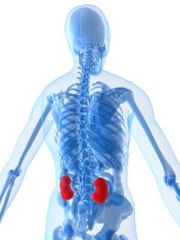The difference between Kidney Pain and Lower Back Pain
The human body is very complex and sometimes the symptoms of two very different conditions  can overlap and refer, creating confusion of where the pain is actually coming from. This is the case with your kidneys, located towards your back and underneath your lower rib cage. Therefore, it’s hard to tell if pain you are experiencing in that area is coming from your lower back or your kidney. Both present very similarly but have completely different causes. Knowing the symptoms location, type and severity of the pain, triggers, and characteristics of these conditions can help you differentiate the
can overlap and refer, creating confusion of where the pain is actually coming from. This is the case with your kidneys, located towards your back and underneath your lower rib cage. Therefore, it’s hard to tell if pain you are experiencing in that area is coming from your lower back or your kidney. Both present very similarly but have completely different causes. Knowing the symptoms location, type and severity of the pain, triggers, and characteristics of these conditions can help you differentiate the
What are the main differences in signs and symptoms, between the kidney and lower back pain?
Please see the table below:
| SYMPTOMS/SIGNS | PAIN ORIGIN | |
| Pain | Kidney | Lower back (musculoskeletal pain) |
| Where | Pain felt in either one or both flanks. This is the area in between your side of hips and lower ribs | Anywhere in the lower back or upper buttocks |
| Characteristics | Kidney pain is usually constant, displaying a pain that is either dull or sharp in nature. Generally, the pain with Kidney’s will only get better if this area is treated and targeted correctly. | The severity of back pain changes throughout the day dependent on certain aggravating body position movements that could trigger pain. For example, sit to stand, prolonged sitting, lying or standing, or bending forward, twisting. The pain is brought on through mechanical movements |
| Relievers | No typical relievers, except treating the underlying disease/problem with the kidney. | Walking (in pinched nerve) Resting (in osteoarthritis) Pain relieving medications, Physiotherapy– manual therapy and the correct exercises |
| Pain radiation | To lower abdomen, groin, inner thigh (in urinary or kidney infection) Kidney pain is classified as either minor or severe. Kidney stones, can sometimes cause nausea and vomiting due to the severity of the pain |
To buttock, back of the thigh, calf, foot, pins and needles and numbness of toes on one side. Varying degrees of pain are also used to describe back pain, with “acute” being back pain that exists for four weeks, “sub-acute” being four to twelve weeks, and “chronic” lasting more than 12 weeks |
| ASSOCIATED SYMPTOMS (sometimes) |
|
|
| SIGNS | ||
| Tenderness to the touch | Only sometimes, and usually directly over the kidney | Dependent on structures that are causing the pain, could be over or near the spine (in spondylitis, Osteoarthritis) Either side of the lower back/gluteal buttock region (muscle spasm/strain) |
| Causes |
|
|
What’s the best treatment for Kidney Pain and Lower back pain?
Kidney pain treatment occurs once the source for its occurrence has been located by your GP. Kidney stones will be aided with the use of pain medication along with increased amounts of water ingestion to accelerate the kidney stone. Surgery may be required in cases of particularly large kidney stones. In cases of infection, antibiotics are used to help remove the bacterial infection.
Lower back pain treatment differs significantly from kidney pain treatment, due to the many different causes. Pain in the back is treated using pain relieving medications along with physiotherapy. These can include manual therapy such as mobilisation, manipulation and massage, exercises to stretch and strengthen, acupuncture and Pilates. If after conservative physiotherapy treatment, pain levels and returning back to normal movement doesn’t improve significantly after a course of 6-8 weeks, then referral back to your GP to request further investigation by a spinal specialist maybe indicated.
If you are unsure on the nature of your back pain and want further information, advice or treatment, don’t hesitate to book in with one of our Physiotherapist’s today at one of the many clinics across Dorset: